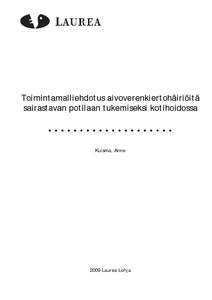| dc.contributor.author | Kuisma, Anne | |
| dc.date.accessioned | 2009-05-28T11:44:41Z | |
| dc.date.available | 2009-05-28T11:44:41Z | |
| dc.date.issued | 2009 | |
| dc.identifier.uri | URN:NBN:fi:amk-200905263216 | |
| dc.identifier.uri | http://www.theseus.fi/handle/10024/3278 | |
| dc.description.abstract | Laurea-ammattikorkeakoulu Tiivistelmä
Laurea Lohja
Hoitotyön koulutusohjelma
Sairaanhoitaja
Tekijä: Anne Kuisma
Opinnäytetyön nimi: Toimintamalliehdotus aivoverenkiertohäiriöitä sairastavan potilaan tukemiseksi kotihoidossa
Vuosi 2009 Sivumäärä 38
Opinnäytetyön tarkoituksena oli kartoittaa aivoverenkiertohäiriöön sairastuneen potilaan hoitoketjua sekä antaa ajankohtaista tietoa aivoverenkiertohäiriöistä ja niiden vaikutuksista. Tavoitteena oli, että aiheeseen liittyvä teoreettinen toimintamalli helpottaisi kotihoidon työntekijöiden työtä teoriapohjan vankentumisen kautta sekä antaisi kokonaisvaltaisemman käsityksen aivoverenkiertohäiriöiden vaikutuksista sairastuneen mielenterveyteen. Lisäksi tavoitteena oli tuottaa ehdotus teoreettisesta toimintamallista aivoverenkiertohäiriöistä kuntoutumisen edistämiseksi ja sairastuneen mielenterveyden tukemiseksi kotihoidossa. Teoreettisen toimintamalliehdotuksen tavoitteena oli parantaa kotihoidon työtekijöiden valmiuksia kohdata aivoverenkiertohäiriöön sairastunut kuntoutumista ja mielenterveyttä edistävällä tavalla.
Opinnäytetyön teoreettinen perusta perustui ajankohtaiseen kirjallisuuteen, artikkeleihin sekä tutkimuksiin. Kirjallisuuskatsauksen pohjalta koottiin keskeiset menetelmät, joiden avulla voidaan tukea aivoverenkiertohäiriöihin sairastuneen kuntoutumista ja mielenterveyttä. Teoreettisen tiedon taustalla oli käsitys ihmisestä kokonaisuutena, johon kuuluvat fyysinen, psyykkinen ja sosiaalinen puoli. Näillä kaikilla on vaikutuksensa toisiinsa, jonka perusteella kuntoutumisen ja mielenterveyden tukemista käsiteltiin tämän kokonaisuuden kautta.
Aivoverenkiertohäiriöihin sairastuneen kuntoutumista ja mielenterveyttä voidaan tukea erilaisin hoitotyön menetelmin. Kuntoutumista ja mielenterveyttä edistävä hoitosuhde edellyttää vastavuoroisuuden ja luottamuksen rakentamista. Ehdotetussa toimintamallissa kuntoutumisen ja mielenterveyden tukeminen sisältää kuusi osa-aluetta, joita ovat kriisissä olevan ihmisen kohtaaminen, mielenterveyden tukeminen, kuntoutumista edistävä hoitotyö, asiakaslähtöisyys, voimavarat sekä toivon ylläpitäminen.
Kotihoidon työntekijöillä on tärkeä merkitys aivoverenkiertohäiriöön sairastuneen kokonaishoidossa, joka käsittää psyykkisen, fyysisen ja sosiaalisen hyvinvoinnin huomioimisen. Työntekijöiden tärkeänä tehtävänä on toivon ylläpitäminen sekä auttaa sairastunutta mahdollisimman omatoimiseen selviytymiseen ja tyytyväisyyteen elämässään. Kirjallisuuskatsaukseen perustuva toimintamalliehdotus jäi teorian tasolla, eikä sen käyttökelpoisuutta arvioitu työelämälähtöisesti.
Opinnäytetyötä voisi laajentaa keräämällä kotihoidon työntekijöiltä palautetta toimintamallin käyttökelpoisuudesta sekä tarvittavia muutos/ lisäys ehdotuksia.
Asiasanat: aivoverenkiertohäiriö, kotihoito, kuntoutuminen, mielenterveys, pitkäaikaissairaus, tukeminen | fi |
| dc.description.abstract | Laurea University of Applied Sciences Abstract
Laurea Lohja
Degree Programme in Nursing
Name: Anne Kuisma
Thesis: Proposal for a plan of action in supporting the homecare of a patient with a stroke
Year 2009 Pages 38
The purpose of the thesis was to map out the chain of treatment for a patient suffering from a stroke. It was also meant to give up-to-date information about the condition, as well as the effects on each situation. The purpose was that the theoretical model of action on the subject would ease up the work load of the home take-carers; mainly by strengthening the basis of theoretical understanding of a stroke, and to give more sufficient understanding of the mental health concerning patients with a stroke. Also, one of the goals was to make a proposal about theoretic model of action in rehabilitating patients, and how to support them mentally in homecare. Purpose for the theoretical model of action was to improve the readiness of caretakers to confront the patients in rehabilitative and mentally strengthening way.
The theoretical basis of the thesis is based on current literature, articles and research. On the basis of the case literature, essential methods were collected, which can help to rehabilitate both mental and physical health of the patient suffering from a stroke. Behind the theoretic knowledge was the thought of a human as one whole entity, including physical, mental and social parts. All these parts affect each other, which gave the reason to study physical and mental rehabilitation as a whole.
Stroke patient’s rehabilitation and mental health can be supported with different caretaking methods. To have the kind of caretaker-patient relationship that supports both the physical and mental rehabilitation, the patient and the caretaker need to build trust on both sides, as well as be able to “give and take”. Proposed model of physical rehabilitation and supporting mental health includes six areas. These are meeting the person in crisis, supporting mental health, action prior to the actual rehabilitation, looking at the situation from a customer’s point of view, current resources and keeping up the hope.
Home-caretakers have a crucial significance in stroke patient’s treatment, enclosing paying attention to the well-being of the mental, physical and social sides. One of the most important parts in caretaker’s job is to keep the patient’s hope up, to help the patient to live self-sufficiently and to make the patient happy in life.
Model of action based on literature available on cerebral ischemia was left on the theory basis, and it was not tried or proved in a working environment.
This thesis could be expanded by getting feedback and suggestions from caretakers on how they would find the model of action in work situation, and also to receive possible ideas on changing of, or adding to the thesis.
Keywords: stroke, homecare, rehabilitation, mental health, long term illness, support | en |
| dc.language.iso | fin | |
| dc.publisher | Laurea-ammattikorkeakoulu | |
| dc.rights | All rights reserved | |
| dc.title | Toimintamalliehdotus aivoverenkiertohäiriöitä sairastavan potilaan tukemiseksi kotihoidossa | fi |
| dc.type.ontasot | fi=AMK-opinnäytetyö|sv=YH-examensarbete|en=Bachelor's thesis| | |
| dc.identifier.dscollection | 10024/261 | |
| dc.organization | Laurea-ammattikorkeakoulu | |
| dc.subject.ysa | aivoverenkiertohäiriöt | fi |
| dc.subject.ysa | potilaat | fi |
| dc.subject.ysa | kotihoito | fi |
| dc.subject.ysa | mielenterveys | fi |
| dc.subject.ysa | kuntoutuminen | fi |
| dc.subject.ysa | tukeminen | fi |
| dc.contributor.organization | Laurea-ammattikorkeakoulu | |
| dc.subject.keyword | aivoverenkiertohäiriö | |
| dc.subject.keyword | kotihoito | |
| dc.subject.keyword | kuntoutuminen | |
| dc.subject.keyword | mielenterveys | |
| dc.subject.keyword | pitkäaikaissairaus | |
| dc.subject.keyword | tukeminen | |
| dc.subject.specialization | sairaanhoitaja | |
| dc.subject.degreeprogram | fi=Hoitotyö|sv=Vård|en=Nursing| | |
| dc.subject.discipline | Hoitotyön koulutusohjelma | |
